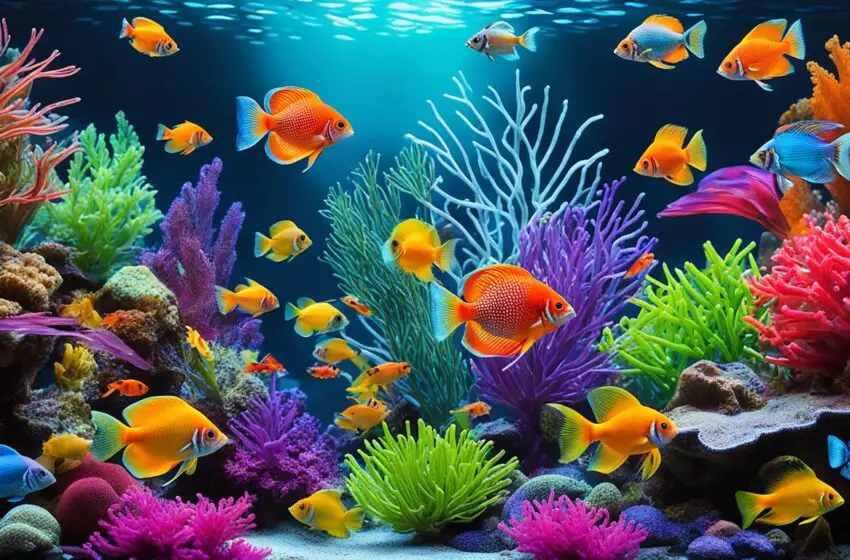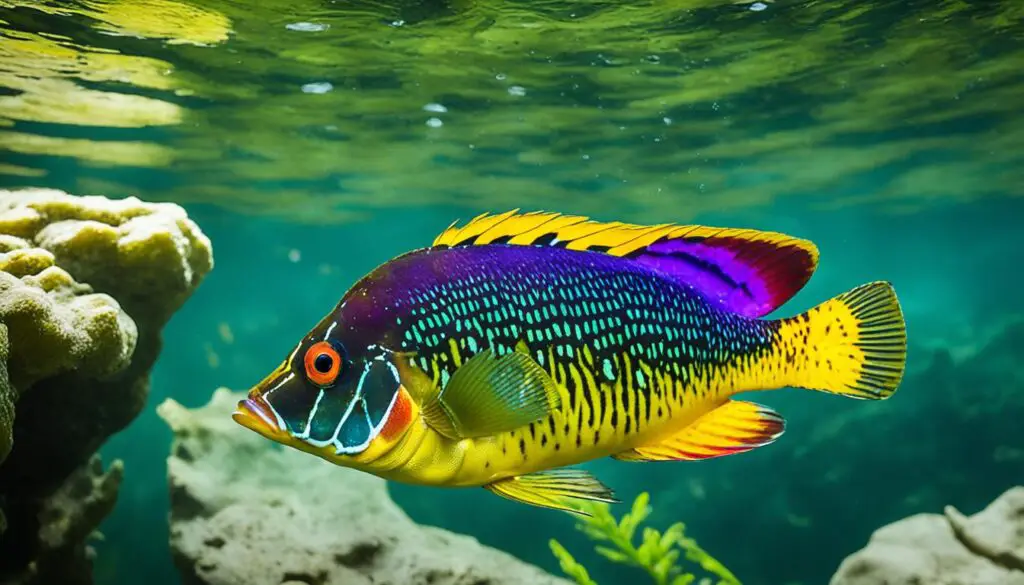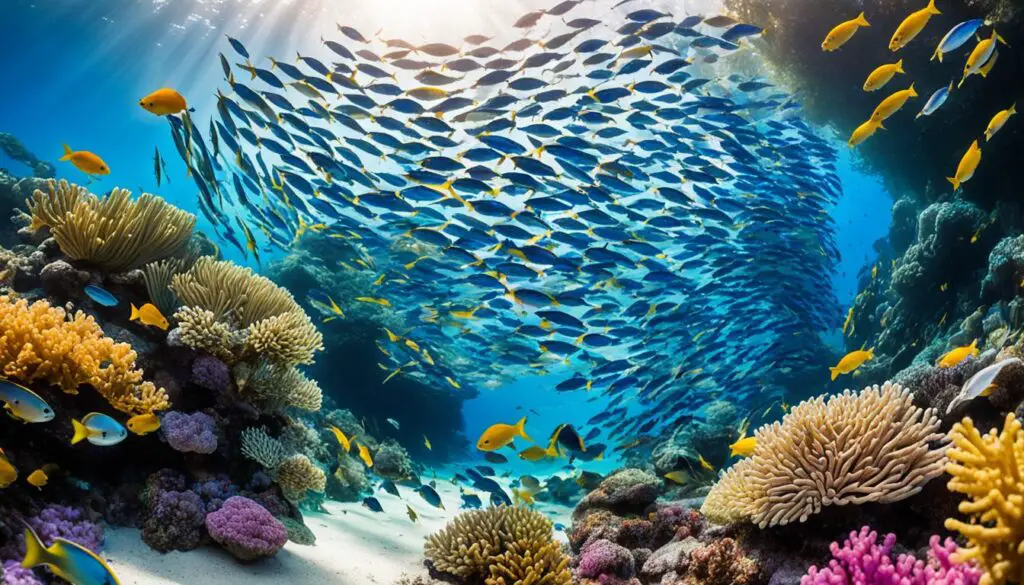Exotic Fish Species: Discover Exotic Wonders: Meet the Most Spectacular Fish Species!

Exotic fish species have always amazed me. As a fish lover, finding unique and beautiful fish is so exciting. It’s not surprising that these types of fish have caught the eye of anglers worldwide.
In Florida, you’ll find a wide range of fish to catch. Many non-native fish have made their homes in the canals, ponds, and sea. These magnificent fish not only offer a great fishing experience but are also tasty to eat.
Fish like the oscar, Mayan cichlid, and pacu, among others, are very popular in Florida. They are the favorites of both local anglers and those coming from afar to fish.
Let’s explore the amazing world of exotic fish in Florida. We’ll see why so many people love the thrill of fishing for these incredible creatures.
Key Takeaways:
- Exotic fish species in Florida offer unique and thrilling fishing experiences.
- The oscar, Mayan cichlid, butterfly peacock bass, blue tilapia, and pacu are among the most spectacular and sought-after species.
- These fish provide anglers with a combination of fighting abilities and delectable taste.
- Fishing for exotic fish species in Florida has become a popular activity for both locals and tourists.
- Exploring this diverse world of fish species is an adventure for anglers of all skill levels.
The Oscar: A Feisty Fighter from South America
The oscar is from Tropical South America. It was first seen in Florida in the late 1950s. Since then, it has spread widely in the warm, wet areas south of Lake Okeechobee. Fishers love the oscar for its tough spirit and good fight. They use small jigs or flies to catch them.
These fish will eat almost anything close to them. This makes them an easy target for those fishing. Oscars are prized not only for their fight but for the tasty white meat they offer.
The Butterfly Peacock Bass: A Vibrant Native of South America
The butterfly peacock bass comes from the Amazon, Orinoco, and Guianas in South America. It was brought to Florida in 1984 to eat unwanted exotic fish. Despite the first struggle with the new climate, this bass has made Florida its home.
Fishers can catch many butterfly peacock bass in spots like Lake Ida. They are beautiful, with colors like bright blue, green, orange, and yellow. Catching them is not easy, adding to the fun for those who fish them.
To catch these bass, fishers use special lures and live shiners. When caught, they fight hard, making fishing a real skill game.

As an angler, the thrill of reeling in a butterfly peacock bass is unmatched. The vibrancy of their colors adds an extra level of excitement to the experience. It’s like holding a work of art in your hands.
Conservation of a Natural Treasure
While these bass are loved for their beauty and thrill in fishing, protecting them is key. We should release them after catching to keep their numbers steady. This preserves their home and keeps South America’s waters in balance.
We as anglers hold the duty to protect these beautiful bass. They symbolize our love and respect for nature. Let’s make sure they stay a treasure for South America’s future.
| Key Features of the Butterfly Peacock Bass | Conservation Tips |
|---|---|
|
|
Conclusion
Fishing for exotic fish species in Florida gives anglers exciting and different fishing experiences. You can aim for the lively oscar or the colorful butterfly peacock bass. These special fish not only fight hard but also taste great. They have made Florida a big draw for fishing tourism, bringing anglers from far and wide to try their luck.
In Florida’s waters, some fish, like the oscar and peacock bass, are common. But others, including the pacu and bullseye snakehead, are still hard to come by. Discovering these exotic fish species can be exciting for any fisherman, no matter their experience level.
Looking for a unique fishing adventure? Florida is the place to be, especially for these exotic fish species. The fights are thrilling, and the fish taste amazing. This means you’ll have a trip you won’t forget in the beautiful Sunshine State. It doesn’t matter if you’re just starting out or you’ve been fishing for years. Florida’s exotic fish species offer something special for everyone.
FAQ
What are the most notable exotic fish species in Florida?
In Florida, the most famous exotic fish include the oscar, Mayan cichlid, butterfly peacock bass, and more. You can also find the blue tilapia and pacu there.
How did the oscar fish first appear in Florida?
In the late 1950s, the oscar fish started showing up in Florida. It quickly made a home in the warm, marshy areas near Lake Okeechobee.
What are some effective techniques for catching oscar fish?
Anglers have luck catching oscars with small jigs and cut bait, or flies. Live crickets can also attract them. They will eat almost anything that looks like food.
Where is the butterfly peacock bass native to and when was it introduced to Florida?
The butterfly peacock bass is from South America’s Amazon, Orinoco, and Guianas rivers. It was brought to Florida in 1984 to control other exotic species.
What lures are commonly used to catch butterfly peacock bass?
To catch butterfly peacock bass, anglers use a range of lures. These include crankbaits, spinnerbaits, poppers, and live shiners.
Are butterfly peacock bass good for eating?
They are good for eating, but the focus is on catch-and-release. This helps keep their numbers up in Florida’s waters.
Are there other exotic fish species in Florida?
Besides the well-known ones, there are others. These include the pacu and bullseye snakehead. However, they are not as commonly seen.

